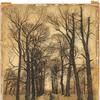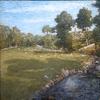Classical Splendor: Painted Furniture for a Grand Philadelphia House
- PHILADELPHIA, Pennsylvania
- /
- August 31, 2016
From September 3, 2016, to January 1, 2017, visitors can get a glimpse into the classical fantasy world of Benjamin Henry Latrobe at the Philadelphia Museum of Art.
Classical Splendor showcases a suite of furniture designed in 1808 by Benjamin Henry Latrobe for the house of Philadelphia merchant William Waln and his wife, Mary. Inspired by the classical art of ancient Greece and Rome, the painted and gilded furniture is one of the greatest artistic triumphs of the early national period. This exhibition will present ten pieces from the Walns’ original set—all from the Museum’s collection—in a new light after comprehensive research and conservation treatment.
The Walns hired Latrobe in 1805 to create a fashionable residence for them on the corner of Seventh and Chestnut Streets, just a block from Pennsylvania’s State House (now known as Independence Hall). With its construction nearing completion in July 1808, Latrobe set about designing the interior wall treatments and furnishings of the house’s social centerpiece—its drawing rooms. The single visual language he developed for these entertaining spaces within the Waln house required the skills of many artisans.
The exhibition will offer new discoveries about the house and the team who created the furniture with Latrobe: cabinetmaker John Aitken, decorative painter George Bridport, and upholsterer John Rea. Demolished in 1847, the Waln house—described as a grand mansion—is known only through the furniture, a small watercolor, two fire insurance surveys, and a handful of descriptions.
The sleek, classical profiles of the Walns’ furniture made a huge impact on American design. A year after the commission, Latrobe reconfigured the public rooms of the President’s House in Washington, DC, for James and Dolley Madison. Although the Madisons’ furniture was destroyed in 1814, Latrobe’s drawings show that he built upon and expanded from the successful designs he had created for the Waln house. Furniture made after the Walns’ commission showed a trend for this new vision of classical design, revealing the Latrobe suite as a watershed in design history.















![Peter Paul Rubens (Flemish, 1577–1640), After Titian (Tiziano Vecelli) (Italian [Venetian], c. 1488–1576), Rape of Europa, 1628–29. Oil on canvas, 71 7/8 x 79 3/8 in. Peter Paul Rubens (Flemish, 1577–1640), After Titian (Tiziano Vecelli) (Italian [Venetian], c. 1488–1576), Rape of Europa, 1628–29. Oil on canvas, 71 7/8 x 79 3/8 in.](/images/c/e2/2e/Jan20_Rape_of_Europa100x100_c.jpg)






![Offering a Truce [Bested], 1895, is estimated to sell for between $1,300,000 and $1,800,000 on March 22, 2014, for The Russell: An Exhibition and Sale to Benefit the C.M. Russell Museum. Offering a Truce [Bested], 1895, is estimated to sell for between $1,300,000 and $1,800,000 on March 22, 2014, for The Russell: An Exhibition and Sale to Benefit the C.M. Russell Museum.](/images/c/a8/20/Dec10_Offering_a_Truce__Bested_300dpi100x100_c.jpg)